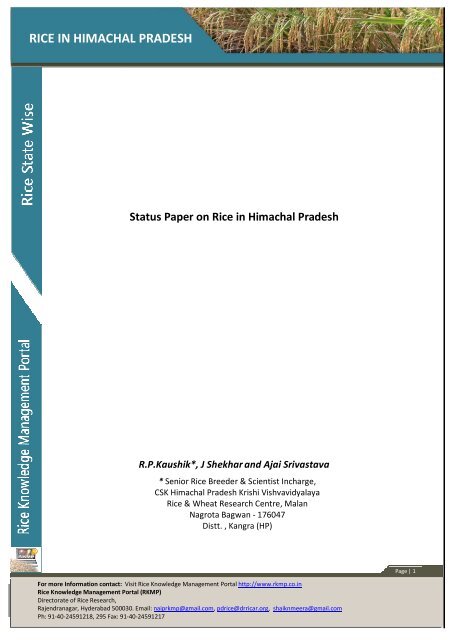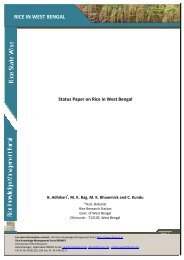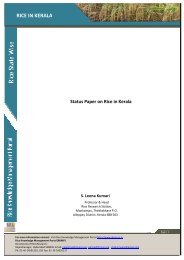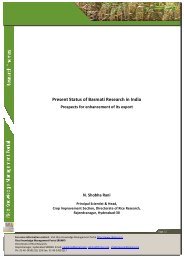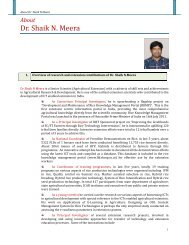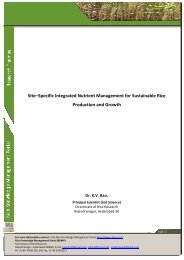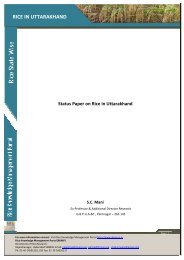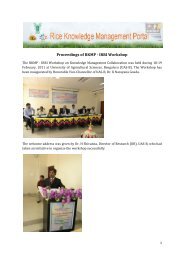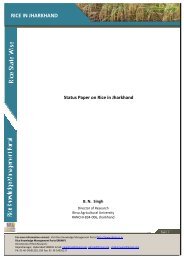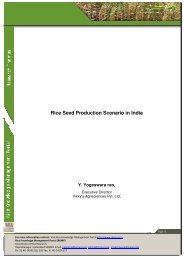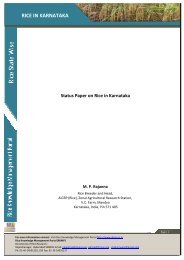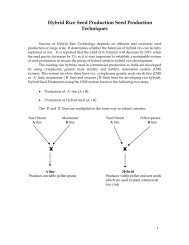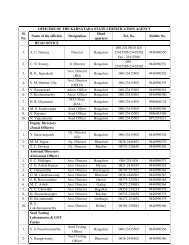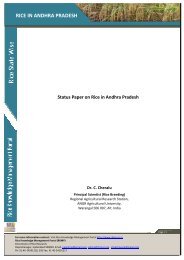RICE IN HIMACHAL PRADESH - Rice Knowledge Management Portal
RICE IN HIMACHAL PRADESH - Rice Knowledge Management Portal
RICE IN HIMACHAL PRADESH - Rice Knowledge Management Portal
- No tags were found...
Create successful ePaper yourself
Turn your PDF publications into a flip-book with our unique Google optimized e-Paper software.
<strong>RICE</strong> <strong>IN</strong> <strong>HIMACHAL</strong> <strong>PRADESH</strong><br />
Status Paper on <strong>Rice</strong> in Himachal Pradesh<br />
R.P.Kaushik*, J Shekhar and Ajai Srivastava<br />
* Senior <strong>Rice</strong> Breeder & Scientist Incharge,<br />
CSK Himachal Pradesh Krishi Vishvavidyalaya<br />
<strong>Rice</strong> & Wheat Research Centre, Malan<br />
Nagrota Bagwan - 176047<br />
Distt. , Kangra (HP)<br />
Page | 1<br />
For more Information contact: Visit <strong>Rice</strong> <strong>Knowledge</strong> <strong>Management</strong> <strong>Portal</strong> http://www.rkmp.co.in<br />
<strong>Rice</strong> <strong>Knowledge</strong> <strong>Management</strong> <strong>Portal</strong> (RKMP)<br />
Directorate of <strong>Rice</strong> Research,<br />
Rajendranagar, Hyderabad 500030. Email: naiprkmp@gmail.com, pdrice@drricar.org, shaiknmeera@gmail.com<br />
Ph: 91-40-24591218, 295 Fax: 91-40-24591217
<strong>RICE</strong> <strong>IN</strong> <strong>HIMACHAL</strong> <strong>PRADESH</strong><br />
I. NAME OF THE STATE: <strong>HIMACHAL</strong> <strong>PRADESH</strong><br />
II.<br />
<strong>IN</strong>TRODUCTION<br />
Himachal Pradesh, which forms a part of the North-Western Himalayas, has a<br />
geographical area of 55,673 sq. km., which is 1.69 per cent of the country’s area and 10.54 per<br />
cent of the Himalayas /Himalayan Landmass. It lies between 30 0 22 ’ 40 ” N to 33 0 12 ’ 40 ” N<br />
latitude and 75 0 47 ’ 55 ” E to 79 0 04 ’ 20 ” E longitude. The State is bordered by Jammu and Kashmir<br />
in the north, Punjab and Haryana in the south-west and part of Uttaranchal in the south-east. In<br />
the north-east the state forms international boundary with Tibet.<br />
According to land use statistics, the state of Himachal Pradesh has an area of 3.396 m ha of<br />
which only 0.558 m ha (16.4%) is the net area sown. Hardly 18 per cent of the total cultivated<br />
area is irrigated. The area sown more than once is 0.414 m ha and the cropping intensity is thus<br />
174 per cent. Forests occupy an area of 1.056 m ha, which is 31.1 per cent of the total area. The<br />
area under pastures and other grazing lands is 1.024 m ha (Anonymous, 2001).<br />
During 2007-2008, rice was cultivated on an area of 78.6 thousand hectares with a<br />
production of 121.4 thousand tonnes and productivity of 1546 kg/ha. <strong>Rice</strong> is cultivated in ten of<br />
the twelve districts of the State except Kinnaur and Lahaul & Spiti with Kangra and Mandi<br />
districts alone accounting for 71.2% of area and 69.7% of production. There is a great diversity of<br />
For more Information contact: Visit <strong>Rice</strong> <strong>Knowledge</strong> <strong>Management</strong> <strong>Portal</strong> http://www.rkmp.co.in<br />
<strong>Rice</strong> <strong>Knowledge</strong> <strong>Management</strong> <strong>Portal</strong> (RKMP)<br />
Directorate of <strong>Rice</strong> Research,<br />
Rajendranagar, Hyderabad 500030. Email: naiprkmp@gmail.com, pdrice@drricar.org, shaiknmeera@gmail.com<br />
Ph: 91-40-24591218, 295 Fax: 91-40-24591217<br />
Page | 2
<strong>RICE</strong> <strong>IN</strong> <strong>HIMACHAL</strong> <strong>PRADESH</strong><br />
agro-climatic conditions under which rice is cultivated and its cultivation extends from foot-hills<br />
(350m) to high hills (upto 2300m).<br />
Bahl Valley (Mandi)<br />
Karsog Valley (Mandi) Ransar Valley (Rohru)<br />
700m 1500m 2200m<br />
II1<br />
ZONAL <strong>IN</strong>FORMATION<br />
a. Climate:<br />
There are three well defined seasons- Summer, Monsoon and Winter. Spring acts as a<br />
transition period between winter and summer, with autumn as an intermediary between the<br />
monsoon and winter. Temperature decreases from west to east. The average temperature<br />
varies from 25 0 C to less than 15 0 C. The Shiwalik and lesser Himalayas record temperature upto<br />
15 0 C but central or middle Himalayan and greater Himalayan regions witness temperatures<br />
below 15 0 C. The highest temperature is recorded in the month of June. The relative humidity is<br />
usually high in the months of July, August, and September and it varies between 76 and 95 per<br />
cent.<br />
b. Soil type and nutrient management:<br />
The rice soils correspond to alluvial loam soil group from sandy clay loam to heavy<br />
textured clay loam. The soil reaction ranges from neutral to strongly acidic. They are usually<br />
deficient to low in available nitrogen, low to medium in respect of available phosphorus. The<br />
available potassium status is rated as medium to high.<br />
For more Information contact: Visit <strong>Rice</strong> <strong>Knowledge</strong> <strong>Management</strong> <strong>Portal</strong> http://www.rkmp.co.in<br />
<strong>Rice</strong> <strong>Knowledge</strong> <strong>Management</strong> <strong>Portal</strong> (RKMP)<br />
Directorate of <strong>Rice</strong> Research,<br />
Rajendranagar, Hyderabad 500030. Email: naiprkmp@gmail.com, pdrice@drricar.org, shaiknmeera@gmail.com<br />
Ph: 91-40-24591218, 295 Fax: 91-40-24591217<br />
Page | 3
<strong>RICE</strong> <strong>IN</strong> <strong>HIMACHAL</strong> <strong>PRADESH</strong><br />
c. Rainfall and its distribution:<br />
Himachal Pradesh experiences considerable variation in the distribution of rainfall and<br />
temperature due to varying aspects and altitudes. Precipitation declines from west to east and<br />
south to north. While the average annual rainfall of Himachal Pradesh is 1111 mm, it varies from<br />
less than 500 mm in Lahaul & Spiti to about 3400 mm in Dharamshala, the district headquarter<br />
of Kangra which is the second wettest place in India after Mausimram in Meghalaya. Lahaul Spiti<br />
records an average annual rainfall of only 434 mm as a result of the rain shadow effect. Spiti is<br />
the driest as it is enclosed by high mountains. Although the State as a whole receives plenty of<br />
rainfall, most of it is experienced during the months of July to September (70%). Very little<br />
snowfall is experienced during winter below 1500 m but at an elevation of 3000 m the average<br />
snowfall is about 3 m, which lasts for four months from December to March. Above 4500 m<br />
there is almost perpetual snow. The amounts of rainfall and snowfall vary with the altitude. The<br />
months of December and January record minimum rain. In the dry temperate zone maximum<br />
snowfall is received from January to March.<br />
Irrigation:<br />
Main source of irrigation is through “Kuhls”. These are small water channels constructed<br />
along the mountain-side loading water from the streams, springs or NALLAHS (rivulets) to the<br />
terraced fields. Tanks account for only 0.3%, canals 1.2% and wells and tube-wells about 4.0 %<br />
and remaining source of irrigation are “Kuhls”. The irrigated rice area has fluctuated between 54<br />
to 58% over the years (Anonymous 2001). This fluctuation of irrigated area depends upon the<br />
precipitation of snow in the mountain ranges and hill-tops during the preceding winter and the<br />
onset and distribution of monsoon rains which is the main source of irrigation through “Kuhls” in<br />
Himachal Pradesh.<br />
d. Agro-climatic zones:<br />
Based on altitude, rainfall, temperature, humidity and topography, four different<br />
homogenous agro-climatic zones may be identified as follows:<br />
For more Information contact: Visit <strong>Rice</strong> <strong>Knowledge</strong> <strong>Management</strong> <strong>Portal</strong> http://www.rkmp.co.in<br />
<strong>Rice</strong> <strong>Knowledge</strong> <strong>Management</strong> <strong>Portal</strong> (RKMP)<br />
Directorate of <strong>Rice</strong> Research,<br />
Rajendranagar, Hyderabad 500030. Email: naiprkmp@gmail.com, pdrice@drricar.org, shaiknmeera@gmail.com<br />
Ph: 91-40-24591218, 295 Fax: 91-40-24591217<br />
Page | 4
<strong>RICE</strong> <strong>IN</strong> <strong>HIMACHAL</strong> <strong>PRADESH</strong><br />
I) Sub-mountain Low Hills and Sub-Tropical – upto 650m amsl<br />
II) Sub-humid Mid Hills<br />
– 650 to 1800m amsl<br />
• Lower altitudinal range 650 to 1500m amsl<br />
• Higher altitudinal range 1500 to 1800 m amsl<br />
III) High Hills Wet Temperate<br />
– 1800 to 2200m amsl<br />
IV) High Hills Dry Temperate Dry – above 2200m amsl<br />
ZONE IV<br />
ZONE I<br />
ZONE II<br />
ZONE III<br />
e. <strong>Rice</strong> and cultural heritage in the state:<br />
<strong>Rice</strong> has an important place in the daily diet of the hill people. It is also an important part<br />
of all religious ceremonies. Chhohartu, a farmers’ red rice variety, grown in Chhohara Valley,<br />
Rohru (Distt. Shimla) is a part of cultural heritage of the area. Since times immemorial the paddy<br />
of this variety is gifted under different names on various occasions such as Poli when gifted on<br />
occasions of happiness like marriages/religious ceremonies/child birth etc., as Path when gifted<br />
to a sick person, and as Sattu on occasions of sorrow such as death of a person. The rice of this<br />
variety is served during community lunches and yajnas. The Pichh (excess water of thick<br />
consistency decanted after cooking of rice) of this red rice is considered very useful for pregnant<br />
ladies and children.<br />
For more Information contact: Visit <strong>Rice</strong> <strong>Knowledge</strong> <strong>Management</strong> <strong>Portal</strong> http://www.rkmp.co.in<br />
<strong>Rice</strong> <strong>Knowledge</strong> <strong>Management</strong> <strong>Portal</strong> (RKMP)<br />
Directorate of <strong>Rice</strong> Research,<br />
Rajendranagar, Hyderabad 500030. Email: naiprkmp@gmail.com, pdrice@drricar.org, shaiknmeera@gmail.com<br />
Ph: 91-40-24591218, 295 Fax: 91-40-24591217<br />
Page | 5
<strong>RICE</strong> <strong>IN</strong> <strong>HIMACHAL</strong> <strong>PRADESH</strong><br />
Chhohartu-the red rice from Chhohara Valley Distt Shimla)<br />
Traditional rice varieties:<br />
The area under traditional rice varieties at present is very less. However, some traditional<br />
varieties are still grown in some isolated pockets because of their wide adaptability to stress<br />
situations like drought, quick germination, quality preference, early maturity and cold tolerance<br />
etc. These are found in mid & high hills. In the mid hills traditional varieties like Kalizhini, Madhu<br />
Malti, Mushkan, Achhoo, Chetru Basmati, Seond Basmati and Ramjawain, are grown for their<br />
local preference for quality (Katoch, et al. 1987; 2003). These varieties have medium bold, long<br />
bold /long slender grains and intermediate amylose content, most of them have mild to strong<br />
aroma, remain moist after cooking but lack basmati like elongation after cooking. In the high<br />
hills, traditional varieties viz., Jattoo, Matali, Lal Dhan, Debal, Zeera, Sukara Dhan etc. have short<br />
bold grains, low amylose content, cook sticky and are tolerant to low temperature. Local people<br />
in the high hills prefer rices, which cooks sticky. In Kullu Valley, high hills of Shimla & Sirmaur<br />
districts, Chamba, and parts of Kangra red rices (red pericarp) are grown because of local<br />
preferences. Some of these red rices include Chhohartu from Rohru (Shimla distt.), Sukara, Tiyun<br />
(Chamba), Lal Zhini, Red Ramjawain from Kangra distt, and Jattoo & Matali from Kullu district.<br />
Annual weedy rice, locally known as “Reesa” is a problem in rice fields in mid hills and to<br />
eradicate this farmers use traditional purple foliage rice varieties like Tapta and Purple China.<br />
Rana et al., (2000) conducted survey of paddy land races in Himachal Pradesh and reported that<br />
about 100 landraces were being grown in the State in late seventies (1977-78) and over a period<br />
of 20 years 50-55% have gone out of cultivation.<br />
For more Information contact: Visit <strong>Rice</strong> <strong>Knowledge</strong> <strong>Management</strong> <strong>Portal</strong> http://www.rkmp.co.in<br />
<strong>Rice</strong> <strong>Knowledge</strong> <strong>Management</strong> <strong>Portal</strong> (RKMP)<br />
Directorate of <strong>Rice</strong> Research,<br />
Rajendranagar, Hyderabad 500030. Email: naiprkmp@gmail.com, pdrice@drricar.org, shaiknmeera@gmail.com<br />
Ph: 91-40-24591218, 295 Fax: 91-40-24591217<br />
Page | 6
<strong>RICE</strong> <strong>IN</strong> <strong>HIMACHAL</strong> <strong>PRADESH</strong><br />
All these traditional varieties are tall, do not respond to high nitrogen and lodge under<br />
high fertility conditions. These varieties are susceptible to blast, a serious problem of hill rice.<br />
IV <strong>RICE</strong> PRODUCTION SCENARIO:<br />
a. Growth trends of area, production and productivity of rice:<br />
The area under rice in the state has decreased from ninety eight thousand hectares in<br />
1971 to around eighty thousand hectares in 2007, but the productivity has increased from 1056<br />
kg to 1546 kg per hectare during this period. This decrease in area is partly due to submergence<br />
of paddy lands under dam reservoirs and partly due to diversification of irrigated area to<br />
vegetables. Growth trends of area, production and productivity of rice during the last thirty<br />
seven years in the state is given in Table 1.<br />
b. Ecosystem-wise productivity:<br />
On the basis of prevailing ambient and irrigation water temperature at various growth<br />
stages of the crop into different altitudinal ranges and the varietal adaptability response, rice<br />
cultivation in the State is grouped in to three zones. There is considerable variation in the<br />
ecosystem as well as zone-wise productivity. Zone-wise altitudinal range, per cent area under<br />
rice and rainfall pattern are given below:<br />
Particulars<br />
Zones<br />
I II III<br />
Altitude (m) Upto 650 650 to 1500 > 1500<br />
Area (%) 26 to 28 60 to 62 12 to 13<br />
Rainfall (mm) About 1000 1200-3400 About 1000<br />
In rainfed upland ecosystem where crop is entirely dependent on rainfall, the productivity is low<br />
and often less than one ton of rice/ha. In irrigated ecosystem in mid hills the productivity is<br />
For more Information contact: Visit <strong>Rice</strong> <strong>Knowledge</strong> <strong>Management</strong> <strong>Portal</strong> http://www.rkmp.co.in<br />
<strong>Rice</strong> <strong>Knowledge</strong> <strong>Management</strong> <strong>Portal</strong> (RKMP)<br />
Directorate of <strong>Rice</strong> Research,<br />
Rajendranagar, Hyderabad 500030. Email: naiprkmp@gmail.com, pdrice@drricar.org, shaiknmeera@gmail.com<br />
Ph: 91-40-24591218, 295 Fax: 91-40-24591217<br />
Page | 7
<strong>RICE</strong> <strong>IN</strong> <strong>HIMACHAL</strong> <strong>PRADESH</strong><br />
about 1.5 tonnes/ha, and in plains & foothills, the productivity is high and touches 2-2.5<br />
tonnes/ha.<br />
c Yield gap and reasons:<br />
The great diversity of agro-climatic conditions under which rice is cultivated in the State<br />
ranging from foot-hills to high–hills, from very high rainfall to low rainfall areas, under<br />
transplanted and wet sown to direct seeded rainfed conditions and from warm sub-tropical to<br />
temperate areas create many constraints to rice production in the State (Katoch et al., 1989).<br />
The average yield of the state in terms of paddy is 22.5 q/ha, whereas the yields in On Farm<br />
Trials are around 40 q/ha and hybrids have shown yield potential of about 75 q/ha in mid hills<br />
below 1000m under good management. In general, the yields in mid and high hills are low,<br />
which can be attributed to following factors:<br />
80<br />
YIELD GAP UNDER IRRIGATED<br />
ECOSYSTEM <strong>IN</strong> HP<br />
75.0<br />
Paddy Yields q/ha<br />
70<br />
60<br />
50<br />
40<br />
30<br />
20<br />
60.0<br />
40.0<br />
22.5<br />
10<br />
0<br />
Hybrid<br />
Pot.<br />
Yld<br />
OFT<br />
State<br />
Av<br />
Inbred Varieties<br />
• Small and fragmented holdings, poor economic condition of the farmer, absentee<br />
landlords and poor management along with non availability of timely inputs.<br />
• Low nutrient use efficiency: In addition to imbalanced fertilizer use, high nutrient losses<br />
occur due to run off on account of terraced rice fields on the hill slopes, undulating<br />
topography and difficult water management.<br />
For more Information contact: Visit <strong>Rice</strong> <strong>Knowledge</strong> <strong>Management</strong> <strong>Portal</strong> http://www.rkmp.co.in<br />
<strong>Rice</strong> <strong>Knowledge</strong> <strong>Management</strong> <strong>Portal</strong> (RKMP)<br />
Directorate of <strong>Rice</strong> Research,<br />
Rajendranagar, Hyderabad 500030. Email: naiprkmp@gmail.com, pdrice@drricar.org, shaiknmeera@gmail.com<br />
Ph: 91-40-24591218, 295 Fax: 91-40-24591217<br />
Page | 8
<strong>RICE</strong> <strong>IN</strong> <strong>HIMACHAL</strong> <strong>PRADESH</strong><br />
• Cloudy weather and short growing season: Average sun shine per day from July to<br />
September is limited to 4 hours only. The crop duration is restricted (seed to seed 125-<br />
130 days) due to closed growing season because of early onset of winters.<br />
d. Contribution to GDP: <strong>Rice</strong> is an important cereal crop of the State next only to maize during<br />
wet season. <strong>Rice</strong> accounts for 10.8 % of area and 10.2 % of production on total food grain<br />
basis and 22.2% of area and 18.8% of production on wet season crops basis in the State.<br />
V. REGION-WISE/DISTRICT-WISE <strong>RICE</strong> ECOSYSTEMS:<br />
There are two main ecosystems under which rice is cultivated in different districts in the state.<br />
In Irrigated ecosystem, where 58 per cent of the rice area lies in the state, following traditional<br />
cultural practices are used for raising rice crop:<br />
• Broadcast of sprouted seeds in puddled fields followed by “HALOD” or “HODD”, a<br />
practice of ponding water in the fields after about three weeks, ploughing with bullock<br />
driven plough, removal of weeds, proper spacing of seedlings and gap filling. The practice<br />
is followed in 10-12 per cent of the areas where timely and assured irrigation is available.<br />
• Broadcast of seed under optimum soil moisture (VATTAR) condition followed by<br />
“HALOD”. The practice is followed in 18-20 per cent of the area.<br />
• Transplanting of 25-30 days old seedlings in puddle fields as per standard method. This<br />
practice is followed in about 30 per cent of the area.<br />
In Rain-fed upland ecosystem: About 42% of rice is grown under rain-fed upland situations. Area<br />
under this ecosystem fluctuates depending upon onset of monsoon rains. Following cultural<br />
practices are generally used under this ecosystem:<br />
• Broadcast or line sowing of seed behind the bullock drawn plough with the pre-monsoon<br />
showers in the mid and high hills. About 8-10 per cent area is covered under this<br />
practice.<br />
• Broadcast of seed with the pre monsoon showers followed by “Halod”. The practice is<br />
followed in about 32-35 per cent of the area.<br />
For more Information contact: Visit <strong>Rice</strong> <strong>Knowledge</strong> <strong>Management</strong> <strong>Portal</strong> http://www.rkmp.co.in<br />
<strong>Rice</strong> <strong>Knowledge</strong> <strong>Management</strong> <strong>Portal</strong> (RKMP)<br />
Directorate of <strong>Rice</strong> Research,<br />
Rajendranagar, Hyderabad 500030. Email: naiprkmp@gmail.com, pdrice@drricar.org, shaiknmeera@gmail.com<br />
Ph: 91-40-24591218, 295 Fax: 91-40-24591217<br />
Page | 9
<strong>RICE</strong> <strong>IN</strong> <strong>HIMACHAL</strong> <strong>PRADESH</strong><br />
VI. <strong>RICE</strong> PRODUCTION AND ECONOMIC ANALYSIS: Though, the rice farmers, in the state are<br />
themselves the consumers of their produce, with the introduction of high yielding varieties and<br />
hybrids, the farmers have now started selling their surplus produce in the local markets and<br />
markets in the adjoining states.<br />
VII. <strong>RICE</strong> AND <strong>RICE</strong> BASED CROPP<strong>IN</strong>G SYSTEMS: As mentioned elsewhere, rice is grown under<br />
two main ecosystems viz., rain-fed and irrigated. Major proportion of the rain-fed rice area goes<br />
to wheat/ wheat + mustard with some areas being put under, barley, lentil, etc. The irrigated<br />
rice area is put to a variety of crops during rabi season. Prominent among them are wheat,<br />
potato, linseed/flax, berseem, oats and vegetables.<br />
VIII. <strong>RICE</strong> GROW<strong>IN</strong>G SEASONS <strong>IN</strong> THE STATE:<br />
Only one crop of rice is grown in the state during wet season from May to October. The<br />
direct seeding and nursery sowings start by the end of May and continue upto about 15 th of<br />
June. However, in Kullu Valley and other higher hills of Shimla, Mandi and Chamba districts of<br />
the State the nursery sowings start as early as mid-April. The transplanting starts around 20 th of<br />
June depending on the onset of monsoons and availability of irrigation water in the area and<br />
continue upto first fortnight of July.<br />
IX.<br />
RECOMMENDED PACKAGE OF PRACTICES:<br />
a) Varieties/hybrids<br />
In the early period pure line selections were made from the local group of varieties<br />
grown by the farmers to meet the quality preferences, higher yield and suitability for different<br />
cultural conditions followed for rice cultivation in the State. As a result of this 9 varieties (<br />
Ramjawain 100, Phul Pattas 72, Lal Nakanda 41, Dhunder 43, R 575, China 988, Norin 18, Norin<br />
8, T 23) were released upto 1971 in the State. Except R 575, a purple foliage variety, which is the<br />
out come from the cross Ramjawain 100/CP-1 (pigmented), all others are either pure line<br />
selections or introductions. These varieties were generally tall, leafy with drooping leaves, and<br />
lodging susceptible and not responsive to fertilizer application.<br />
For more Information contact: Visit <strong>Rice</strong> <strong>Knowledge</strong> <strong>Management</strong> <strong>Portal</strong> http://www.rkmp.co.in<br />
<strong>Rice</strong> <strong>Knowledge</strong> <strong>Management</strong> <strong>Portal</strong> (RKMP)<br />
Directorate of <strong>Rice</strong> Research,<br />
Rajendranagar, Hyderabad 500030. Email: naiprkmp@gmail.com, pdrice@drricar.org, shaiknmeera@gmail.com<br />
Ph: 91-40-24591218, 295 Fax: 91-40-24591217<br />
Page | 10
<strong>RICE</strong> <strong>IN</strong> <strong>HIMACHAL</strong> <strong>PRADESH</strong><br />
Japonica varieties:<br />
The yield potential of rice varieties developed through pure line selection and inter<br />
varietal hybridization in forties and fifties was very limited. However, during this period japonica<br />
varieties viz., Norin 18, and Norin 8 were also introduced in the mid hills of Himachal Pradesh<br />
because of their cold tolerance and responsiveness to fertilizers and recommended for<br />
cultivation under irrigated conditions from 1000 to 1500m altitude in 1967 and 1968,<br />
respectively. Today these varieties are grown only in some isolated pockets. Out of five typical<br />
japonicas, imported from Japan in 1995 by DRR, Hyderabad two entries namely “Koshihikari”and<br />
“Hinohikari” were found to be most promising varieties for yield and quality parameters based<br />
on three years of testing in hills. Koshihikari has been found to be suitable for cultivation above<br />
1500 m altitude, where as Hinohikari in the mid hills upto 1500 m altitude. In 2005 variety Bhrigu<br />
Dhan developed from a cross Chucheng/Deval ®//Matali at Research Sub Station, Katrain, H.P.<br />
was released by the State Variety Release Committee. This variety has red grains and yield<br />
potential of 6.5 to 7.0 t/ha with an average yield of 3.8 t/ha in high altitude locations above 1500<br />
m.<br />
High yielding varieties:<br />
Although, advent of semi-dwarf varieties in late sixties led to the green revolution in the<br />
tropics, yet the spread of semi-dwarf varieties in higher altitudes in tropics was delayed because<br />
these varieties were late maturing and lacked cold tolerance. Systematic programme for<br />
germplasm improvement for developing cold and drought tolerant and blast resistant varieties<br />
for hills was started in 1970-71 at Palampur/Malan (Himachal Pradesh) with the intensification<br />
of research on rice under the All India Coordinated <strong>Rice</strong> Improvement Project (AICRIP). Under<br />
this scheme, a multi disciplinary approach is being followed for the development of cold tolerant<br />
cultures of rice with blast resistance. From 1975 onwards our crossing programme involved<br />
crosses among semi-dwarfs found suitable for higher altitudes and crosses of semi-dwarfs with<br />
local/improved tall traditional varieties. In 1986, Himalaya 741 a selection from early generation<br />
materials in the International <strong>Rice</strong> Cold Tolerance Nursery was released for general cultivation in<br />
For more Information contact: Visit <strong>Rice</strong> <strong>Knowledge</strong> <strong>Management</strong> <strong>Portal</strong> http://www.rkmp.co.in<br />
<strong>Rice</strong> <strong>Knowledge</strong> <strong>Management</strong> <strong>Portal</strong> (RKMP)<br />
Directorate of <strong>Rice</strong> Research,<br />
Rajendranagar, Hyderabad 500030. Email: naiprkmp@gmail.com, pdrice@drricar.org, shaiknmeera@gmail.com<br />
Ph: 91-40-24591218, 295 Fax: 91-40-24591217<br />
Page | 11
<strong>RICE</strong> <strong>IN</strong> <strong>HIMACHAL</strong> <strong>PRADESH</strong><br />
the State. The variety was cold tolerant, had durable resistance to blast and was suitable for<br />
cultivation in both irrigated and rainfed upland ecosystems. It gave yields as high as 7t/ha on<br />
farmers field demonstrations and remained a very popular variety with the farmers for 6-7 years<br />
before it succumbed to blast in 1992 (Sharma et al., 1983).<br />
Till date 20 rice varieties have been released for different ecosystems and altitudinal<br />
ranges in the mid and high hills of Himachal Pradesh. The detailed information of these varieties<br />
is given in the Table 2. Presently the notable varieties for irrigated conditions in high hills above<br />
1500m altitude are Naggar Dhan, Bhrigu Dhan and Varun Dhan. In the mid hills (650 to 1500m)<br />
predominant varieties under irrigated conditions are HPR 2143, HPR 1068, RP 2421, Palam Dhan<br />
957, Kasturi (upto 1000m) and Hassan Serai (1000 to 1300m), whereas under rainfed conditions,<br />
China 988, VL Dhan 221 and Sukara Dhan 1 are popular. RP 2421, a predominant variety for the<br />
last 15 years due to its early maturity and resistance to blast in mid hills, has now succumbed to<br />
blast during Kharif 2009 season. Palam Dhan 957, though now susceptible to blast is still liked by<br />
farmers due to its very high yield potential and good grain and cooking quality. These varieties<br />
occupy about 62-65 per cent of the rice area in themid hills. In low hills/plain areas (upto 650m)<br />
varieties from adjoining states (Punjab, Haryana & Western UP) are generally cultivated and<br />
among them IR 8, Jaya, HKR 126 and PR series among non-scented and Pusa Basmati 1, Traori<br />
Basmati and Basmati 370 among basmati are predominant. A number of breeding lines from the<br />
State have been found to be resistant donors for different diseases and insect pests (Table 4).<br />
RP 2421 devastated by neck blasduring kharif 2009<br />
For more Information contact: Visit <strong>Rice</strong> <strong>Knowledge</strong> <strong>Management</strong> <strong>Portal</strong> http://www.rkmp.co.in<br />
<strong>Rice</strong> <strong>Knowledge</strong> <strong>Management</strong> <strong>Portal</strong> (RKMP)<br />
Directorate of <strong>Rice</strong> Research,<br />
Rajendranagar, Hyderabad 500030. Email: naiprkmp@gmail.com, pdrice@drricar.org, shaiknmeera@gmail.com<br />
Ph: 91-40-24591218, 295 Fax: 91-40-24591217<br />
Page | 12
<strong>RICE</strong> <strong>IN</strong> <strong>HIMACHAL</strong> <strong>PRADESH</strong><br />
HRI 152 - A Blockbuster Hybrid<br />
(Commercialised as Hybrid 6129)<br />
WS2006<br />
Ish Kumar Oct 10, 06<br />
Hybrid rice: Scope and limitations in the State:<br />
Except for some academic studies, which included identification of maintainers,<br />
restorers, heterotic combinations and assessment of out-crossing rates of different CMS lines<br />
under mid hill conditions, not much headway has been made under hybrid rice. However, for<br />
the irrigated ecosystem of low hills and valley areas upto 650 m altitude of the State, rice<br />
hybrids developed in the AICRIP programme and adjoining states have been directly introduced,<br />
evaluated and adopted by farmers for cultivation. In 2007, HRI 152 (ARIZE 6129) was<br />
recommended by the University for general cultivation in the state for irrigated areas below<br />
1000m elevations. Over the years the hybrid showed high level of resistance to blast and fitted<br />
well in the rice-wheat rotation. It gave yields as high as 8.5 t/ha at RWRC, Malan. The hybrid is<br />
now fast spreading in the Bahl Valley of Mandi District and parts of Kangra district.<br />
Hybrid<br />
HRI 152<br />
For more Information contact: Visit <strong>Rice</strong> <strong>Knowledge</strong> <strong>Management</strong> <strong>Portal</strong> http://www.rkmp.co.in<br />
<strong>Rice</strong> <strong>Knowledge</strong> <strong>Management</strong> <strong>Portal</strong> (RKMP)<br />
Directorate of <strong>Rice</strong> Research,<br />
Rajendranagar, Hyderabad 500030. Email: naiprkmp@gmail.com, pdrice@drricar.org, shaiknmeera@gmail.com<br />
Ph: 91-40-24591218, 295 Fax: 91-40-24591217<br />
Page | 13
<strong>RICE</strong> <strong>IN</strong> <strong>HIMACHAL</strong> <strong>PRADESH</strong><br />
b) <strong>Management</strong> inclusive of mechanization<br />
Nutrient management:<br />
Nutrient recommendations for rice vary with the kind of varieties being grown.<br />
Nutrients (kg/ha)<br />
Fertilizers<br />
N P 2 O 5 K 2 O kg/ha kg/bigha (800m 2 )<br />
Urea SSP MOP Urea SSP MOP<br />
High yielding Vars: 90 40 40 195 250 65 16 20 5<br />
Local varieties: 50 25 25 108 156 42 9 12 3<br />
It is recommended to apply whole of phosphorus and potash and half nitrogen prior to<br />
last puddling operation and the remaining nitrogen in two splits- one 3 weeks after<br />
transplanting and the other 3-4 weeks later at panicle initiation stage. In case, FYM is added<br />
@ 5 t/ha on dry weight basis then only half the recommended dose of nutrients should be<br />
given. In acidic soils in high rainfall regions and submersed areas the application of P 2 O 5 and<br />
K 2 O may be avoided if these nutrients have been applied in recommended doses to the<br />
preceding rabi crop. In water logged soils where only paddy crop is taken, only nitrogen and<br />
phosphorus may be applied @ 60 kg and 40 kg/ha, respectively.<br />
Zinc deficiency:<br />
Zinc deficiency is wide spread and frequent where top soil has been removed or soils<br />
have high pH, high CaCO 3 and high organic matter content. The characteristic symptom of<br />
zinc deficiency in paddy is bloaching of the mid rib of leaves. Zinc deficiency can be corrected<br />
by application of zinc sulphate @ 25 kg/ha. In transplanted paddy, mild zinc deficiency can<br />
also be corrected by dipping seedlings for 30 minutes in 2% zinc oxide solution prior to<br />
transplanting. Zinc sulphate should be applied at least 2 days after the application of P<br />
For more Information contact: Visit <strong>Rice</strong> <strong>Knowledge</strong> <strong>Management</strong> <strong>Portal</strong> http://www.rkmp.co.in<br />
<strong>Rice</strong> <strong>Knowledge</strong> <strong>Management</strong> <strong>Portal</strong> (RKMP)<br />
Directorate of <strong>Rice</strong> Research,<br />
Rajendranagar, Hyderabad 500030. Email: naiprkmp@gmail.com, pdrice@drricar.org, shaiknmeera@gmail.com<br />
Ph: 91-40-24591218, 295 Fax: 91-40-24591217<br />
Page | 14
<strong>RICE</strong> <strong>IN</strong> <strong>HIMACHAL</strong> <strong>PRADESH</strong><br />
fertilizer. If the deficiency symptoms appear on the leaves, 0.5% zinc sulphate solution<br />
(@750 L/ha) should be sprayed.<br />
Effect of Zinc Application at ORS, Kangra duing Kharif 2008<br />
8-8-08 28-8-08<br />
Iron deficiency/ Iron toxicity:<br />
Light textured soils with high pH are prone to iron deficiency prevalent in Una district.<br />
<strong>Rice</strong> seedlings raised on such soils exhibit yellowing of the newly emerged leaf. In the absence of<br />
corrective measures the whole seedling may become white and later die. Iron toxicity is<br />
commonly observed in flooded rice soils in Palam Valley of Kangra district.<br />
Weed <strong>Management</strong>:<br />
In Himachal Pradesh, rice is mainly raised/ established through three methods viz.,direct<br />
seeding (in unpuddled fields), direct seeding of sprouted seeds in puddled fields and<br />
transplanting. In broadcast sown sprouted or dry seeded rice, an interculture operation locally<br />
called as ‘halod’ which involves use of bullock driven desi plough in standing rice after<br />
impounding 8-10 cm water in the field about 25-30 days after sowing is quite common. This<br />
operation is carried out to check weed growth and fill the gaps.<br />
To ensure effective weed control in direct sown rice, chemical method of weed control is<br />
very effective and economical. For the control of grassy weeds in direct seeding in unpuddled<br />
fields it is recommended to use Butachlor @ 1.5 kg or Pendimethalin 1.5 kg or Oxadiazon 0.75 kg<br />
in 750 L water per hectare 2 days after sowing.<br />
For more Information contact: Visit <strong>Rice</strong> <strong>Knowledge</strong> <strong>Management</strong> <strong>Portal</strong> http://www.rkmp.co.in<br />
<strong>Rice</strong> <strong>Knowledge</strong> <strong>Management</strong> <strong>Portal</strong> (RKMP)<br />
Directorate of <strong>Rice</strong> Research,<br />
Rajendranagar, Hyderabad 500030. Email: naiprkmp@gmail.com, pdrice@drricar.org, shaiknmeera@gmail.com<br />
Ph: 91-40-24591218, 295 Fax: 91-40-24591217<br />
Page | 15
<strong>RICE</strong> <strong>IN</strong> <strong>HIMACHAL</strong> <strong>PRADESH</strong><br />
In sprouted rice culture, grassy weeds can be kept under check by the application of<br />
granular formulation of Butachlor @ 1.5 kg or liquid formulation of Butachlor @ 1.5 kg mixed<br />
well in 150 kg sand and broadcast in one hectare in 4-5 cm standing water 7 days after sowing.<br />
Butachlor (liquid formulation) mixed with safener can also be applied 3 days after sowing.<br />
Alternatively, the grassy weeds in this culture can also be controlled by Pyrazosulfuron-ethyl<br />
0.025 kg per hectare 8-12 days after sowing or Cyhalofop-butyl 0.09 kg per hectare 15-20 days<br />
after sowing.<br />
In transplanted rice culture, the puddling of field and proper water management<br />
destroys many weeds and saves the crop from the first flush of weeds for about two weeks after<br />
transplanting. The weeds appear thereafter and should be controlled. With popularization of<br />
SRI the use of cono-weeder is also becoming popular among the transplanted rice farmers. The<br />
common herbicides recommended for controlling grassy weeds in transplanted rice are<br />
Butachlor 1.5 kg (granular or liquid) or Pendimethalin 1.5 kg or Oxyfluorfen 0.15 kg using 750 L<br />
water per hectare 4-5 days after transplanting. Use of Pyrazosulfuron-ethyl 0.025 kg per hectare<br />
8-12 days after sowing or Cyhalofop-butyl 0.09 kg per hectare 15-20 days after sowing also gives<br />
effective control of the grassy weeds.<br />
The broad leaved weeds and sedges in all the above mentioned rice cultures can be<br />
effectively and conveniently controlled by 2-4 DEE @ 0.8 kg applied 20-25 days after<br />
transplanting or 30-35 days after direct seeding.<br />
Precautions:<br />
• Do not apply granular formulations of herbicides in direct seeded upland rice.<br />
• Use hand gloves while applying machete or mixing with hand.<br />
• Do not tank mix cyhalofop-butyl with 2,4-D<br />
• To avoid the herbicide resistance problem, follow herbicide rotations<br />
Note: In case of light textured soils, reduce the dose of herbicides by 25%.<br />
<strong>Management</strong> of Insect-pests and diseases<br />
For more Information contact: Visit <strong>Rice</strong> <strong>Knowledge</strong> <strong>Management</strong> <strong>Portal</strong> http://www.rkmp.co.in<br />
<strong>Rice</strong> <strong>Knowledge</strong> <strong>Management</strong> <strong>Portal</strong> (RKMP)<br />
Directorate of <strong>Rice</strong> Research,<br />
Rajendranagar, Hyderabad 500030. Email: naiprkmp@gmail.com, pdrice@drricar.org, shaiknmeera@gmail.com<br />
Ph: 91-40-24591218, 295 Fax: 91-40-24591217<br />
Page | 16
<strong>RICE</strong> <strong>IN</strong> <strong>HIMACHAL</strong> <strong>PRADESH</strong><br />
Leaf hopper: The nymphs and adults cause heavy damage during August-September.<br />
• Spray carbaryl 50 WP @ 1500 g/ ha or monocroptophos 1500 ml /ha.<br />
• Repeat application if hopper population persists beyond a week after application.<br />
Caseworm: The pest is active during September and damage is done to both direct seeded and<br />
transplanted rice.<br />
• Spray 1250 ml chlorpyriphos 20 EC (0.05%) in 500 litre water per hectare.<br />
Chaffer bettles (Popillia lucida ): The beetle is active during flowering stage of the crop. Peak<br />
activity is observed from the last week of August to second week of September.<br />
• Spray Cypermethrin 10 EC @ 625 ml/ha or Chlorpyriphos 20 EC @ 1250ml/ha at panicle<br />
emergence stage of the crop for the control of<br />
<strong>Management</strong> practices for rice hispa, leaf folder, stem borer and whorl maggot are mentioned<br />
under IPM<br />
Blast: The disease damages the crop both at leaf and neck stages. The severity is some times so<br />
intense that it results in total loss of the crop.<br />
• Treat the seed before sowing with Bavistin 50WP or Beam 75WP (2 kg/ha seed).<br />
• Spray the crop with Blitox 50 (Copper oxychloride) once at nursery stage (12 g in 4 L<br />
water for 100 m 2 ) and again depending on the need at the time of tillering, panicle<br />
emergence and late booting stages with 2.250 kg Blitox 50 WP or 750 g Bavistin 50 WP or<br />
750 ml Hinosan in 750 L water/ha or 300g Beam 75WPin 500 L water/ha.<br />
• Do not apply excessive doses of nitrogenous fertilizer<br />
• Plant resistant varieties HPR 2143, HPR 1068, Sukara Dhan 1, VL Dhan 22 and Kasturi.<br />
False smut: High relative humidity, rainy and cloudy days during the flowering period increase<br />
incidence of the disease. Disease incidence is high on hybrids.<br />
• Collect the diseased panicles and burn them.<br />
For more Information contact: Visit <strong>Rice</strong> <strong>Knowledge</strong> <strong>Management</strong> <strong>Portal</strong> http://www.rkmp.co.in<br />
<strong>Rice</strong> <strong>Knowledge</strong> <strong>Management</strong> <strong>Portal</strong> (RKMP)<br />
Directorate of <strong>Rice</strong> Research,<br />
Rajendranagar, Hyderabad 500030. Email: naiprkmp@gmail.com, pdrice@drricar.org, shaiknmeera@gmail.com<br />
Ph: 91-40-24591218, 295 Fax: 91-40-24591217<br />
Page | 17
<strong>RICE</strong> <strong>IN</strong> <strong>HIMACHAL</strong> <strong>PRADESH</strong><br />
• Avoid excessive doses of nitrogen fertilizers.<br />
• Give two sprays of copper oxychloride 50WP (0.3%) at heading and 10 days after this.<br />
Bacterial blight: Known to be a disease of tropics, it has made is appearance in the mid-hills<br />
over the last 10 years probably due to climate change.<br />
• Before seeding dip the seed in 5% salt solution to remove light seeds.<br />
• Plant resistant varieties like RP 2421, HPR 1068, Sukara Dhan 1 etc.<br />
• Do not apply excessive dose of nitrogen.<br />
• Do not pound water in the field.<br />
X. <strong>IN</strong>DIGENOUS TECHNICAL KNOWLEDGE (ITK) SPECIFIC TO STATE: At the time of planting,<br />
the traditional rice farmers put branches of Vitex nigundo (Banah) at the water inlet of rice<br />
fields anticipating control of leaf blast. Leaves of this plant are also scattered in the rice fields.<br />
Similarly, the leaves of Ageratum and Lantana are scattered in the field to control rice hispa.<br />
Leaves of Darek (Melia azardirachta) are used for safe storage of rice.<br />
XI. BYE-PRODUCTS/EXTENDED USE OF <strong>RICE</strong> SPECIFIC TO THE STATE:<br />
There is acute shortage of fodder for cattle in the hill state. As a result paddy straw is<br />
used as fodder for the cattle and for bedding purpose in house hold dairies. Local beverage<br />
called, “Zhol” is prepared from rice. In religious places puffed rice in the form of “Khil” and<br />
“Murmure” prepared from local rice varieties is sold for offering. “Chirwa”, prepared from<br />
beaten rice is used as breakfast cereal. Few rice farmers and other people use stuffing of<br />
paddy straw for making “Bandri” a kind of mat used for bedding purposes. A mixture of hull<br />
and bran called “Fuk” is sold in the market as feed for horses and poultry.<br />
XII. <strong>RICE</strong> AND COMMERCE (Exports and revenue generation):<br />
In general in mid and high hills the land holdings are very small and rice yields are low, as<br />
a result the farmer is the consumer also. There is no regulated market for rice in the state.<br />
However, there is great demand for some speciality rices of the state like red rices and scented<br />
For more Information contact: Visit <strong>Rice</strong> <strong>Knowledge</strong> <strong>Management</strong> <strong>Portal</strong> http://www.rkmp.co.in<br />
<strong>Rice</strong> <strong>Knowledge</strong> <strong>Management</strong> <strong>Portal</strong> (RKMP)<br />
Directorate of <strong>Rice</strong> Research,<br />
Rajendranagar, Hyderabad 500030. Email: naiprkmp@gmail.com, pdrice@drricar.org, shaiknmeera@gmail.com<br />
Ph: 91-40-24591218, 295 Fax: 91-40-24591217<br />
Page | 18
<strong>RICE</strong> <strong>IN</strong> <strong>HIMACHAL</strong> <strong>PRADESH</strong><br />
rices which get premium in the market. Chhohartu, a red rice variety, grown in an area of<br />
about 1000 ha in Chhohara Valley, Rohru (Distt Shimla) is in great demand because of its unique<br />
red pericarp colour. It is sold in the local market at a premium price of more than Rs 100 per kg.<br />
XIV STATUS OF RECENT <strong>RICE</strong> PRODUCTION TECHNOLOGIES:<br />
a. SRI: Based on experimentation at the <strong>Rice</strong> & Wheat Research Centre, Malan and at the main<br />
campus of the Himachal Pradesh Krishi Vishvavidyalaya, a package of practice for SRI in the<br />
state was given to the farmers in 2009. For the last three years the Peoples’ Science Institute,<br />
Dehradun has been engaged in propagating SRI in the state with the help of different NGOs,<br />
the State department of Agriculture and the University scientists. Now based on encouraging<br />
results the state government is also giving push to this technology by providing weeders and<br />
markers on subsidized rates.<br />
b. Hybrid rice: Spread of hybrid rice in the mid hills was delayed due to non availability of early<br />
maturing and blast resistant hybrids. It was only in 2006 that from the All India Coordinated<br />
Irrigated Hybrid <strong>Rice</strong> Trial –Early, two hybrids HRI 152 and R6329 were found to be early<br />
maturing and blast resistant at the <strong>Rice</strong> & Wheat Research Centre, Malan. Of these HRI 152<br />
(ARIZE 6129) was finally recommended by the university for general cultivation in the state<br />
for irrigated areas below 1000m elevations. Over the years the hybrid showed high level of<br />
resistance to blast and fitted well in the rice-wheat rotation. It gave yields as high as 8.5 t/ha<br />
at RWRC, Malan. The hybrid is now fast spreading in the Bahl Valley of Mandi District and<br />
parts of Kangra district.<br />
c. Aerobic rice/conservation agriculture: The work on aerobic rice and conservation agriculture<br />
in rice crop is still in infancy.<br />
d. Biotechnological interventions/golden rice: Marker Assisted Selection for pyramiding blast<br />
resistant genes from Fukunishiki and Tetep and bacterial blight resistant genes from IR 24<br />
pyramid lines is being done in collaboration with the Biotechnology Centre of the university.<br />
Blast resistant pyramid lines are in advanced stages of testing at the Centre and the material<br />
with xa5, xa13 and Xa21 bacterial blight resistant genes is in BC 2 F 3 generation.<br />
For more Information contact: Visit <strong>Rice</strong> <strong>Knowledge</strong> <strong>Management</strong> <strong>Portal</strong> http://www.rkmp.co.in<br />
<strong>Rice</strong> <strong>Knowledge</strong> <strong>Management</strong> <strong>Portal</strong> (RKMP)<br />
Directorate of <strong>Rice</strong> Research,<br />
Rajendranagar, Hyderabad 500030. Email: naiprkmp@gmail.com, pdrice@drricar.org, shaiknmeera@gmail.com<br />
Ph: 91-40-24591218, 295 Fax: 91-40-24591217<br />
Page | 19
<strong>RICE</strong> <strong>IN</strong> <strong>HIMACHAL</strong> <strong>PRADESH</strong><br />
e. IPM/IDM: The integrated pest & disease management strategies, being followed in<br />
collaboration with the Bio-control lab of the Department of Agriculture are given below:<br />
Pest<br />
monitoring<br />
technique<br />
used<br />
i) Rapid Roving survey<br />
ii) Field scouting<br />
iii) Agro ecosystem<br />
analysis<br />
Light trap monitoring<br />
iv) Pheromone/ light trap<br />
Economic<br />
threshold<br />
level<br />
i) Leaf folder,<br />
Cnaphalocrocis medinalis<br />
10 % damaged leaves or 3 freshly<br />
damaged leaves/ hill at post active<br />
tillering stage<br />
ii) <strong>Rice</strong> hispa, Dicladispa<br />
armigera<br />
10 % damaged leaves or 2-3 freshly<br />
damaged leaves/ hill<br />
iii) Stem borer,<br />
Scirpophaga innotata<br />
5 % dead hearts or 1 egg mass/ m 2 or 1<br />
adult moth/ m 2<br />
IPM strategies:<br />
Crop stage/<br />
month<br />
Pest(s)<br />
<strong>Management</strong> practices<br />
Nursery Stem borer o Apply chlorpyriphos 20 EC @ 1250 ml/ ha or<br />
Carbofuran @ 33 kg/ ha in nursery, 5-7 days before<br />
For more Information contact: Visit <strong>Rice</strong> <strong>Knowledge</strong> <strong>Management</strong> <strong>Portal</strong> http://www.rkmp.co.in<br />
<strong>Rice</strong> <strong>Knowledge</strong> <strong>Management</strong> <strong>Portal</strong> (RKMP)<br />
Directorate of <strong>Rice</strong> Research,<br />
Rajendranagar, Hyderabad 500030. Email: naiprkmp@gmail.com, pdrice@drricar.org, shaiknmeera@gmail.com<br />
Ph: 91-40-24591218, 295 Fax: 91-40-24591217<br />
Page | 20
<strong>RICE</strong> <strong>IN</strong> <strong>HIMACHAL</strong> <strong>PRADESH</strong><br />
May-June<br />
Whorl<br />
maggot<br />
Nematodes<br />
pulling the seedlings for transplanting.<br />
o In stem borer endemic areas, install pheromone traps<br />
with 5 mg lure @ 8 traps/ ha for pest monitoring.<br />
Planting to<br />
panicle<br />
initiation/<br />
flowering<br />
stage July-<br />
Sept.<br />
Stem borer<br />
Leaf folder<br />
o Clipping of leaf tips of the seedlings at the time of<br />
transplanting will help in destruction of egg masses of<br />
stem borer, whorl maggot and immature stages of<br />
hispa<br />
o Remove the left over nursery and incorporate into<br />
soil.<br />
o Install pheromone traps with 5 mg lure @ 8 traps/ ha<br />
for pest monitoring or 20 traps/ ha for direct mass<br />
trapping.<br />
o Inundative release of egg parasitoid, Trichogramma<br />
japonicum five to six times @ 50,000 adults/ ha<br />
starting from 15 DAT.<br />
o Apply carbofuran (Furadan 3 G) by broadcasting in 3-4<br />
cm standing water @ 1 kg a.i./ha(33.3 kg of<br />
formulation), 10 DAT or 40 days old direct sown crop<br />
or by end of July /early August. If necessary the<br />
treatment can be repeated after 40 days. OR<br />
o Spray 1000 ml endosulfan 35 EC or 500ml methyl<br />
parathion (Metacid 50 EC) in 500 L of water at the<br />
appearance of the pest.<br />
• Spray chlorpyriphos 20 EC @ 1250 ml/ha in 500 L of<br />
water or monocrotophos 36 EC@ 835 ml/ha at the<br />
appearance of the pest.<br />
Page | 21<br />
For more Information contact: Visit <strong>Rice</strong> <strong>Knowledge</strong> <strong>Management</strong> <strong>Portal</strong> http://www.rkmp.co.in<br />
<strong>Rice</strong> <strong>Knowledge</strong> <strong>Management</strong> <strong>Portal</strong> (RKMP)<br />
Directorate of <strong>Rice</strong> Research,<br />
Rajendranagar, Hyderabad 500030. Email: naiprkmp@gmail.com, pdrice@drricar.org, shaiknmeera@gmail.com<br />
Ph: 91-40-24591218, 295 Fax: 91-40-24591217
<strong>RICE</strong> <strong>IN</strong> <strong>HIMACHAL</strong> <strong>PRADESH</strong><br />
• Inundative release of egg parasitoid, Trichogramma<br />
chilonis five to six times @ 50,000 adults/ ha starting<br />
from 15 DAT.<br />
<strong>Rice</strong> hispa<br />
• Broadcast cartap (Padan 4 G) in 3-4 cm standing water<br />
@ 1 Kg a.i./ha(4 Kg of formulation), 10 DAT or 40 days<br />
old direct sown crop or by end of July /early August. If<br />
necessary repeat the treatment after 40 days. OR<br />
• Spray 600 ml methyl parathion (Metacid 50 EC)<br />
or1000 ml fenitrothion in 500 L of water at the<br />
appearance of the pest. OR<br />
Flowering<br />
and after<br />
Stem borer<br />
Leaf folder<br />
• Spray chlorpyriphos 20 EC @ 1250 ml/ha in 500 L of<br />
water at 10 DAT fb another spray of chlorpyriphos or<br />
Neemazal @ 1500ml/ha after 40 days of first spray.<br />
Spray 1000 ml endosulfan 35 EC or 500ml methyl<br />
parathion (Metacid 50 EC) in 500 L of water, if pest<br />
population approaches ETL of 5% white ears.<br />
Spray chlorpyriphos 20 EC @ 1250 ml/ha in 500 L of<br />
water or monocrotophos 36 EC@ 835 ml/ha, if pest<br />
population approaches ETL of 10% damaged leaves.<br />
Chaffer beetle<br />
Page | 22<br />
For more Information contact: Visit <strong>Rice</strong> <strong>Knowledge</strong> <strong>Management</strong> <strong>Portal</strong> http://www.rkmp.co.in<br />
<strong>Rice</strong> <strong>Knowledge</strong> <strong>Management</strong> <strong>Portal</strong> (RKMP)<br />
Directorate of <strong>Rice</strong> Research,<br />
Rajendranagar, Hyderabad 500030. Email: naiprkmp@gmail.com, pdrice@drricar.org, shaiknmeera@gmail.com<br />
Ph: 91-40-24591218, 295 Fax: 91-40-24591217
<strong>RICE</strong> <strong>IN</strong> <strong>HIMACHAL</strong> <strong>PRADESH</strong><br />
XV.<br />
Organizations of Agricultural Research in the State:<br />
Organizational set up for rice research:<br />
The research work on rice was started in the hilly areas of erstwhile undivided Punjab<br />
during the year 1936 at Saloh near Bhattoo, district Kangra now in Himachal Pradesh. During<br />
1970-71, ICAR sanctioned a main center of an All India Coordinated <strong>Rice</strong> Improvement Project<br />
for Himachal Pradesh having multidisciplinary approach with head quarter at Palampur. It was,<br />
subsequently inherited by H.P. Krishi Vishvavidyalaya, Palampur in 1978. In 1980 the university<br />
purchased additional land at Malan (Nagrota Bagwan) and the head quarter of Coordinated <strong>Rice</strong><br />
Improvement Project was shifted to this location in 1985. This station is situated in the Kangra<br />
Valley on Pathankot-Mandi highway about 4 km from Nagrota Bagwan town at an elevation of<br />
950m amsl at latitude 32 0 1’ N and longitude 76 0 2’ E.<br />
Present set up<br />
Main <strong>Rice</strong> & Wheat Research Centre, Malan (Distt Kangra) HP.1936/1985: Headquarter of All<br />
India Coordinated <strong>Rice</strong> Improvement Project,.<br />
Department of Crop Improvement, Palampur, District Kangra (Mid hills)-1970: Testing and<br />
evaluation center for cold tolerant and short duration genotypes.<br />
Research Sub Station, Sundernagar, Distt. Mandi (Mid hills)-1962: Testing and evaluation<br />
center for rain-fed upland rice.<br />
Research Sub Station, Katrain, District Kullu (High hills)-1981-82: Research on cold tolerant<br />
and japonica rices.<br />
Regional Research and Extension Centre, Dhaulakuan, District Sirmaur (Low Hills & Valley<br />
areas): Testing and evaluation centre for long duration and basmati genotypes.<br />
Extension work in the state is carried out through a net work of Krishi Vigyan Kendras and<br />
the State Department of Agriculture extension set up at grass root level.<br />
For more Information contact: Visit <strong>Rice</strong> <strong>Knowledge</strong> <strong>Management</strong> <strong>Portal</strong> http://www.rkmp.co.in<br />
<strong>Rice</strong> <strong>Knowledge</strong> <strong>Management</strong> <strong>Portal</strong> (RKMP)<br />
Directorate of <strong>Rice</strong> Research,<br />
Rajendranagar, Hyderabad 500030. Email: naiprkmp@gmail.com, pdrice@drricar.org, shaiknmeera@gmail.com<br />
Ph: 91-40-24591218, 295 Fax: 91-40-24591217<br />
Page | 23
<strong>RICE</strong> <strong>IN</strong> <strong>HIMACHAL</strong> <strong>PRADESH</strong><br />
XVI.<br />
CONSTRA<strong>IN</strong>TS TO <strong>RICE</strong> PRODUCTION:<br />
a. Biotic stress: Diseases, Insects, Nematodes and Weeds<br />
Among diseases rice blast is the major constraint followed by glume discolouration and<br />
brown spot. Blast epidemics are of frequent occurrence in the hills and the life of an improved<br />
popular variety is hardly 4-5 years. This is because of the buildup of inoculum of the new virulent<br />
race affecting the variety. In low hills and valley areas bacterial blight (BLB), stem rot and sheath<br />
blight also cause considerable damage. Whereas, among insect pests rice hispa, leaf folder and<br />
stem borer are important. Brown plant hoppers and white backed plant hoppers are also<br />
problems in low hills.<br />
Shift in the spectrum of diseases and insect pests: Diseases viz., false smut, sheath blight,<br />
bacterial blight and leaf spot, which were of minor nature earlier in hill rices are becoming<br />
important probably due to climate change. Bacterial blight has also started appearing in the mid<br />
hills. In 2007 hopper burn was observed for the first time in Kangra Valley in mid hills. Similarly<br />
insect pests viz., rice whorl maggot, case worm, brown plant hopper, white backed plant hopper,<br />
leafhoppers, Chaffer beetles and white grubs are now causing considerable damage to rice crop<br />
more frequently. In addition, white tip and root knot nematode problem has also increased<br />
particularly in the nursery beds and upland rice crop.<br />
Weeds in different ecosystems:<br />
The upland rice environment is favourable for the germination of a variety of weeds.<br />
These germinate almost simultaneously with the rice seeds. Prevalent weeds in this ecosystem<br />
are Grasses: Echinochloa crusgalli, Echinochloa colonum,, Cynodon dactylon, Panicum<br />
dichotomiflorum, Ischaemum rugosum, Setaria sps., Paspalum sps., Sedges: Cyperus rotundus,<br />
Cyperus esculentus and Broadleaved: Ageratum conyzoides, Commelina benghalensis,<br />
Aeschynomene indica, Phyllanthus niruri, Euphorbia heterophylla etc.<br />
Prevalent weeds in puddle and flooded rice are: Grasses: Echinochloa colonum, E. crusgalli,<br />
Paspallum sp, Cynodon dactylon, Sedges: Cyperus iria, Cyperus difformis, Cyperus esculentus,<br />
For more Information contact: Visit <strong>Rice</strong> <strong>Knowledge</strong> <strong>Management</strong> <strong>Portal</strong> http://www.rkmp.co.in<br />
<strong>Rice</strong> <strong>Knowledge</strong> <strong>Management</strong> <strong>Portal</strong> (RKMP)<br />
Directorate of <strong>Rice</strong> Research,<br />
Rajendranagar, Hyderabad 500030. Email: naiprkmp@gmail.com, pdrice@drricar.org, shaiknmeera@gmail.com<br />
Ph: 91-40-24591218, 295 Fax: 91-40-24591217<br />
Page | 24
<strong>RICE</strong> <strong>IN</strong> <strong>HIMACHAL</strong> <strong>PRADESH</strong><br />
Eriocaulon sps, Scirpus sps. Broad leaved: Monochoria vaginalis , Ammania pentandra , Ipomoea<br />
aquatic, Eclipta alba, Aeschynomene indica, etc.<br />
Generally weeds cause 25 to 40 per cent yield losses and is a major problem in direct<br />
seeded rain-fed rice, where the yield losses may go as high as 60 per cent.<br />
b. Abiotic stresses: Cold irrigation and ambient temperatures during growing season and<br />
drought due to erratic monsoon are the major abiotic stresses:<br />
Low temperature stress: About 60% of rice area of the state falling in mid and high hills is<br />
affected by cold stress due to cool irrigation water and/or low ambient temperature. Of this 12%<br />
area in high hills suffers cold stress at seedling as well as reproductive stages, whereas the<br />
remaining area in mid hills experience cold stress at reproductive stages only. The mean<br />
maximum/minimum temperature during different stages of crop growth at four representative<br />
centers in the low (Dhaulakuan), mid hills (Malan & Palampur) and high hills (Katrain) of the<br />
State are given in Table 3. The mean maximum/minimum temperatures during reproductive<br />
phase are in the range of 31-26/21-16 0 C at Dhaulakuan and 22-18/13-8 0 C at Katrain.<br />
Low temperatures due to snowfall in higher hills in<br />
September induces sterility<br />
Low temperature induced sterility at Karsog during Kh 2009 due to late planting<br />
Drought stress: In addition to 42% rain-fed area, even the irrigated area suffers from inadequate<br />
and irregular irrigation water availability depending mainly on snow fall in the high hills during<br />
the preceding winter and delayed onset and early withdrawal of monsoon rains.<br />
For more Information contact: Visit <strong>Rice</strong> <strong>Knowledge</strong> <strong>Management</strong> <strong>Portal</strong> http://www.rkmp.co.in<br />
<strong>Rice</strong> <strong>Knowledge</strong> <strong>Management</strong> <strong>Portal</strong> (RKMP)<br />
Directorate of <strong>Rice</strong> Research,<br />
Rajendranagar, Hyderabad 500030. Email: naiprkmp@gmail.com, pdrice@drricar.org, shaiknmeera@gmail.com<br />
Ph: 91-40-24591218, 295 Fax: 91-40-24591217<br />
Page | 25
<strong>RICE</strong> <strong>IN</strong> <strong>HIMACHAL</strong> <strong>PRADESH</strong><br />
c. Institutional constraints: Lack of State Seed Corporation and non availability of timely<br />
inputs like seed and fertilizer are major institutional constraints.<br />
d. Socio-economic constraints: Small land holdings, absentee land lords, terraced sloppy<br />
fields, difficult water management, poor economic condition of farmer are major<br />
socio-economic factors.<br />
XVII.<br />
STATUS OF SEED PRODUCTION OF MAJOR VARIETIES/AGENCIES <strong>IN</strong>VOLVED/<br />
DEMAND AND SUPPLY<br />
The state of Himachal Pradesh does not have a State Seed Corporation to regulate seed<br />
production in the state. <strong>Rice</strong> & Wheat Research Centre, Malan is the only source of basic seed<br />
i.e. nucleus & breeder seed and produces about 30-40 quintal breeder seed every year. This<br />
seed is then given to the State Deptt. of Agriculture for further multiplication on Govt. Seed<br />
Multiplication Farms. However, for the last few years the Govt. Seed Multiplication Farms are<br />
almost defunct. Now the Krishi Vigyan Kengras of the University are producing seed through the<br />
Seed Village setup. The Deptt. of Agriculture is also following this seed village chain for seed<br />
multiplication now. The seed replacement is about 15% per annum.<br />
Breeder/Foundation Seed Produced at RWRC,<br />
Malan<br />
Varieties 2004 2005 2006 2007 2008<br />
RP 2421 5.4 4.3 5.2 2.1 2.2<br />
HPR 2143 0.6 4.3 6.3 8.7 12.0<br />
HPR 1068 1.0 3.2 7.4 8.0 15.4<br />
Kasturi 1.5 1.5 2.3 7.3 3.0<br />
Hassan serai 0.2 0.5 0.5 0.8 0.1<br />
Sukara Dhan 1 1.0 2.5 2.2 7.2 7.0<br />
VL 221 1.3 1.3 2.2 4.2 0.7<br />
Bhrigu Dhan 0.7 0.2 0.6 0.2 0.2<br />
Varun Dhan - - 0.3 0.3 0.2<br />
Total 12.3 18.0 24.8 38.8 40.8<br />
For more Information contact: Visit <strong>Rice</strong> <strong>Knowledge</strong> <strong>Management</strong> <strong>Portal</strong> http://www.rkmp.co.in<br />
<strong>Rice</strong> <strong>Knowledge</strong> <strong>Management</strong> <strong>Portal</strong> (RKMP)<br />
Directorate of <strong>Rice</strong> Research,<br />
Rajendranagar, Hyderabad 500030. Email: naiprkmp@gmail.com, pdrice@drricar.org, shaiknmeera@gmail.com<br />
Ph: 91-40-24591218, 295 Fax: 91-40-24591217<br />
Page | 26
<strong>RICE</strong> <strong>IN</strong> <strong>HIMACHAL</strong> <strong>PRADESH</strong><br />
XVIII. Future strategies:<br />
Because of undulating topography, highly diverse agro-ecology of hills and about 45 per<br />
cent area under rainfed rice coupled with low temperature stress at different stages of crop<br />
growth in mid and high hills and serious problem of blast disease, more precise location specific<br />
research need to be conducted for different altitudinal ranges in the hills. The priority areas of<br />
research for improvement of hill rice in the State are:<br />
• Enhancement hill rice genetic resources through collection and conservation. Molecular<br />
characterization of elite germplasm (improved & traditional) and identification of<br />
nutritionally superior, blast resistant and cold tolerant genotypes and utilization in breeding<br />
programmes.<br />
• Development of rice varieties with higher yield potential, durable resistance to pests<br />
particularly blast and superior grain quality through recombinant breeding for rainfed upland<br />
and irrigated ecosystems.<br />
• DNA marker technology for gene characterization, marker assisted selection and gene<br />
pyramiding using biotechnological tools to incorporate durable resistance to blast.<br />
Assessment of genetic diversity in the host, pest and pathogen of rice.<br />
For more Information contact: Visit <strong>Rice</strong> <strong>Knowledge</strong> <strong>Management</strong> <strong>Portal</strong> http://www.rkmp.co.in<br />
<strong>Rice</strong> <strong>Knowledge</strong> <strong>Management</strong> <strong>Portal</strong> (RKMP)<br />
Directorate of <strong>Rice</strong> Research,<br />
Rajendranagar, Hyderabad 500030. Email: naiprkmp@gmail.com, pdrice@drricar.org, shaiknmeera@gmail.com<br />
Ph: 91-40-24591218, 295 Fax: 91-40-24591217<br />
Page | 27
<strong>RICE</strong> <strong>IN</strong> <strong>HIMACHAL</strong> <strong>PRADESH</strong><br />
References:<br />
Anonymous, 2001. Fertilizer Statistics: 2000-01. The Fertilizer Association of India, New Delhi.<br />
46: III 2- 102.<br />
Katoch, P.C., Sharma, S.L. and Kaushik, R.P. 2003. The Aromatic <strong>Rice</strong>s of Himachal Pradesh. In A<br />
Treatise on the Scented <strong>Rice</strong>s of India. R.K. Singh,& U.S. Singh (Ed). KalyaniPublication,<br />
Ludhiana.pp 287-298.<br />
Katoch, P.C., Sharma, S.L. and Kaushik, R.P. and Gupta, J.C. 1987. <strong>Rice</strong> – Status of germplasm<br />
collection, storage, evaluation and future scope in Himachal Pradesh. Paper presented at<br />
the Special Group Discussion on <strong>Rice</strong> Germplasm organised by Directorate of <strong>Rice</strong><br />
Research and National Bureau of Plant Genetic Resources at New Delhi. 23-24 July, 1987.<br />
Katoch, P.C., Sharma, S.L. and Kaushik, R.P. and Gupta, J.C. 1989. Constraints to rice production<br />
in Himachal Pradesh. Indian Farming. 38(12): 4-6.<br />
Rana, J.C. Sharma, B.D. and Gautam, P.L. 2000. Agri-diversity erosion in the north-west Indian<br />
Himalayas – some case studies. Indian J. Pl. Genet. Resources. 13(3): 252-258.<br />
Sharma, K.D., Kaushik, R.P., Sharma, S.L. and Katoch, P.C. 1983. HPU 741, a promising early, cold<br />
tolerant rice variety. Intl. <strong>Rice</strong> Research Newsletter. 8(5): 9-10.<br />
For more Information contact: Visit <strong>Rice</strong> <strong>Knowledge</strong> <strong>Management</strong> <strong>Portal</strong> http://www.rkmp.co.in<br />
<strong>Rice</strong> <strong>Knowledge</strong> <strong>Management</strong> <strong>Portal</strong> (RKMP)<br />
Directorate of <strong>Rice</strong> Research,<br />
Rajendranagar, Hyderabad 500030. Email: naiprkmp@gmail.com, pdrice@drricar.org, shaiknmeera@gmail.com<br />
Ph: 91-40-24591218, 295 Fax: 91-40-24591217<br />
Page | 28
<strong>RICE</strong> <strong>IN</strong> <strong>HIMACHAL</strong> <strong>PRADESH</strong><br />
Table 1: Growth trends of rice production and productivity in Himachal Pradesh (1971-2007)<br />
Year<br />
Areas<br />
Production<br />
Productivity<br />
Irrigated<br />
(’000ha)<br />
(‘000t)<br />
(kg/ha)<br />
Area (%)<br />
1971 97.7 103.2 1056 54.4<br />
1972 95.0 88.0 910 -<br />
1973 97.0 118.0 1214 -<br />
1974 92.0 97.0 1051 -<br />
1975 94.4 124.1 1300 53.8<br />
1976 87.9 98.2 1117 -<br />
1977 88.3 114.1 1292 -<br />
1978 98.5 122.8 1247 -<br />
1979 97.6 87.5 897 -<br />
1980 109.4 96.9 886 -<br />
1981 91.3 95.6 1040 55.6<br />
1982 88.2 73.0 828 -<br />
1983 92.8 111.5 1202 -<br />
1984 94.8 117.2 1236 -<br />
1985 90.8 125.4 1382 56.1<br />
1986 95.9 105.6 1101 -<br />
Page | 29<br />
For more Information contact: Visit <strong>Rice</strong> <strong>Knowledge</strong> <strong>Management</strong> <strong>Portal</strong> http://www.rkmp.co.in<br />
<strong>Rice</strong> <strong>Knowledge</strong> <strong>Management</strong> <strong>Portal</strong> (RKMP)<br />
Directorate of <strong>Rice</strong> Research,<br />
Rajendranagar, Hyderabad 500030. Email: naiprkmp@gmail.com, pdrice@drricar.org, shaiknmeera@gmail.com<br />
Ph: 91-40-24591218, 295 Fax: 91-40-24591217
<strong>RICE</strong> <strong>IN</strong> <strong>HIMACHAL</strong> <strong>PRADESH</strong><br />
1987 90.2 76.1 844 -<br />
1988 86.6 89.8 1037 -<br />
1989 88.7 94.5 1065 -<br />
1990 84.9 106.5 1254 -<br />
1991 83.3 103.0 1237 60.0<br />
1992 81.9 110.3 1347 61.4<br />
1993 823 101.9 1238 57.0<br />
1994 82.6 112.2 1358 61.4<br />
1995 82.5 111.2 1348 61.4<br />
1996 81.7 108.6 1329 58.6<br />
1997 86.2 120.4 1397 58.1<br />
1998 82.8 117.8 1423 -<br />
1999 80.2 120.4 1501 -<br />
2000 81.5 124.9 1532<br />
2001 80.6 137.4 1705<br />
2003 81.3 120.6 1463<br />
2004 77.0 120.0 1558<br />
2007 78.4 121.4 1536<br />
Source: Fertilizer statistics/ Statistical Outline of Himachal Pradesh<br />
Page | 30<br />
For more Information contact: Visit <strong>Rice</strong> <strong>Knowledge</strong> <strong>Management</strong> <strong>Portal</strong> http://www.rkmp.co.in<br />
<strong>Rice</strong> <strong>Knowledge</strong> <strong>Management</strong> <strong>Portal</strong> (RKMP)<br />
Directorate of <strong>Rice</strong> Research,<br />
Rajendranagar, Hyderabad 500030. Email: naiprkmp@gmail.com, pdrice@drricar.org, shaiknmeera@gmail.com<br />
Ph: 91-40-24591218, 295 Fax: 91-40-24591217
<strong>RICE</strong> <strong>IN</strong> <strong>HIMACHAL</strong> <strong>PRADESH</strong><br />
Table 2: Salient features of <strong>Rice</strong> Varieties Released in Himachal Pradesh during 1970-2007<br />
Variety Year Adaptability Maturity<br />
(Days)<br />
Av.Yield<br />
(t/ha)<br />
T 23* 1971 Irrigated(< 1000m) 140-145 2.5-3.0<br />
IR 579 1975 Irrigated(< 1000m) 140-145 4.0-4.5<br />
Himdhan 1978 Irrigated(mid-hills) 130-135 3.5-4.0<br />
Himalaya 1* 1982 Irrigated(mid-hill) 115-120 4.0-4.5<br />
Himalaya 2* 1982 Irrigated(mid-hills) 120-125 3.5-4.0<br />
Himalaya 741* 1986 Irrigated & rainfed (mid-hills) 115-125 3.8-4.2<br />
Himalaya 799* 1992 Irrigated (mid-hills) 120-125 3.7-4.0<br />
Naggar Dhan 1992 Irrigated (>1400m) 135-140 3.5-4.0<br />
RP 732 1992 Irrigated (Low hills) 130-135 5.0-5.5<br />
Himalaya 2216* 1994 Irrigated (mid-hills) 125-130 3.8-4.2<br />
RP 2421* 1994 Irrigated (mid-hills) 120-125 3.7-4.0<br />
Kasturi 1994 Irrigated (
<strong>RICE</strong> <strong>IN</strong> <strong>HIMACHAL</strong> <strong>PRADESH</strong><br />
Sukara Dhan 1 2004 Rainfed (mid-hills) 115-120 2.8-3.2<br />
HPR 2143 2005 Irrigated (mid-hills) 125-130 3.5-4.0<br />
HPR 1068 2005 Irrigated (mid-hills) 120-125 3.8-4.5<br />
Bhrigu Dhan 2005 Irrigated (>1200m) 150-155 3.3-4-4<br />
Varun Dhan 2007 Irrigated (>1200 m) 140-145 2.5-3.6<br />
* Varieties which are now susceptible to blast<br />
Page | 32<br />
For more Information contact: Visit <strong>Rice</strong> <strong>Knowledge</strong> <strong>Management</strong> <strong>Portal</strong> http://www.rkmp.co.in<br />
<strong>Rice</strong> <strong>Knowledge</strong> <strong>Management</strong> <strong>Portal</strong> (RKMP)<br />
Directorate of <strong>Rice</strong> Research,<br />
Rajendranagar, Hyderabad 500030. Email: naiprkmp@gmail.com, pdrice@drricar.org, shaiknmeera@gmail.com<br />
Ph: 91-40-24591218, 295 Fax: 91-40-24591217
<strong>RICE</strong> <strong>IN</strong> <strong>HIMACHAL</strong> <strong>PRADESH</strong><br />
Table 3: Ambient temperatures during various growth stages of rice crop at representative<br />
locations in Himachal Pradesh<br />
Centres Altitude (m) Prevailing temperatures o C (Max. /Min.)<br />
Seedling Tillering Flowering Maturity<br />
Dhaulakuan 467 39-33/25-21 35-36/25-22 32-28/23-17 31-26/21-16<br />
(low hills) H H H to M H to M<br />
Malan 950 36-31/23-18 33-27/24-19 29-24/20-15 28-23/18-13<br />
(mid hills) H to M H to M M M to L<br />
Palampur 1290 32-27/21-16 29-25/21-27 26-22/17-13 25-21/16-11<br />
(mid hills) H to M M M to L M to L<br />
Katrain 1525 29-24/18-12 28-22/18-14 25-20/15-11 22-18/13-8<br />
(high hills) M M M to L L to VL<br />
H = High, L = Low, M = Moderate, VL = Very Low<br />
Table 4. HP breeding lines identified as resistant donors to different diseases and insect pests<br />
at national level<br />
Donor varieties<br />
Insect pests<br />
Stem Borer HPU 824, HPU 838, HPU 862, Himalaya 2216, RP 2421<br />
<strong>Rice</strong> Hispa HPR-1198, HPR 2025, HPR 2031, HPR 2033, HPR 932<br />
Leaf Folder HPR-2031, HPR 2032, HPR 2033 , HPR 2001, HPR 2002, HPR 2086<br />
For more Information contact: Visit <strong>Rice</strong> <strong>Knowledge</strong> <strong>Management</strong> <strong>Portal</strong> http://www.rkmp.co.in<br />
<strong>Rice</strong> <strong>Knowledge</strong> <strong>Management</strong> <strong>Portal</strong> (RKMP)<br />
Directorate of <strong>Rice</strong> Research,<br />
Rajendranagar, Hyderabad 500030. Email: naiprkmp@gmail.com, pdrice@drricar.org, shaiknmeera@gmail.com<br />
Ph: 91-40-24591218, 295 Fax: 91-40-24591217<br />
Page | 33
<strong>RICE</strong> <strong>IN</strong> <strong>HIMACHAL</strong> <strong>PRADESH</strong><br />
Gundhi Bug HPR 2054<br />
Diseases<br />
Leaf Blast HPR 2001, HPR 2083, , HPR 2315, HPR 2352, HPR 2501, HPR 2593,<br />
Neck Blast HPR 2143,, HPR 2302, HPR 2339, HPR 2363, HPR-2373, HPR 2512<br />
Leaf & Neck Blast HPR 2072, HPR 2167, HPR 2309, HPR 2322, HPR 2329, HPR 2504<br />
Sheath Blight HPR 2163<br />
Sheath Rot HPR 1179, HPR 2362<br />
Bacterial Leaf Blight HPR 2001, HPR 2129, HPR 2315, HPR 2413, HPR 2505, HPR 2530<br />
<strong>Rice</strong> Tungro Virus HPR 2001, HPR 2083, HPR 2310, HPR 2373<br />
For more Information contact: Visit <strong>Rice</strong> <strong>Knowledge</strong> <strong>Management</strong> <strong>Portal</strong> http://www.rkmp.co.in<br />
<strong>Rice</strong> <strong>Knowledge</strong> <strong>Management</strong> <strong>Portal</strong> (RKMP)<br />
Directorate of <strong>Rice</strong> Research,<br />
Rajendranagar, Hyderabad 500030. Email: naiprkmp@gmail.com, pdrice@drricar.org, shaiknmeera@gmail.com<br />
Ph: 91-40-24591218, 295 Fax: 91-40-24591217<br />
Page | 34


